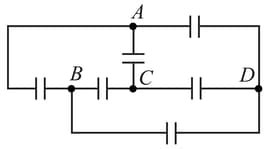Determine the force of interaction between two hemispheres of radius touching each other along the equator if one hemisphere is uniformly charged with a surface density and the other with a surface density .

Important Questions on Electricity and Magnetism
The minimum strength of a uniform electric field that can tear a conducting uncharged thin-walled sphere into two parts is known to be . Determine the minimum electric field strength required to tear the sphere of twice as large radius if the thickness of its walls is the same as in the former case.
Three small identical neutral metal balls are at the vertices of an equilateral triangle. The balls are in turn connected to an isolated large conducting sphere whose centre is on the perpendicular erected from the plane of the triangle and passing through its centre. As a result, the first and second balls have acquired charges, and respectively. Determine the charge of the third ball.
A metal sphere of radius charged to potential is then placed in a thin-walled uncharged conducting spherical shell of radius . Determine the potential acquired by the spherical shell after it has been connected for a short time to the sphere by a conductor.

A very small earthed conducting sphere is at a distance from a point charge and at a distance from a point charge . At a certain instant, the sphere starts expanding so that its radius grows according to the law . Determine the time dependence of the current in the earthing conductor, assuming that the point charges and the centre of the sphere are at rest, and in due time the initial point charges get into the expanding sphere without touching it (through small holes).
Three uncharged capacitors of capacitance , and are connected as shown in Fig. to one another and to points , and at potentials , and . Determine the potential at point .

The thickness of a flat sheet of a metal foil is , and its area is . A charge is located at a distance from the centre of the sheet such that
Determine the force with which the sheet is attracted to the charge , assuming that the straight line connecting the charge to the centre of the sheet is perpendicular to the surface of the sheet.
Where must a current source be connected to the circuit shown in the figure, in order to charge all the six capacitors having equal capacitances?

A parallel-plate capacitor is filled by a dielectric whose permittivity varies with the applied voltage according to the law , where . The same (but containing no dielectric) capacitor charged to a voltage is connected in parallel to the first "nonlinear" uncharged capacitor. Determine the final voltage across the capacitors.
